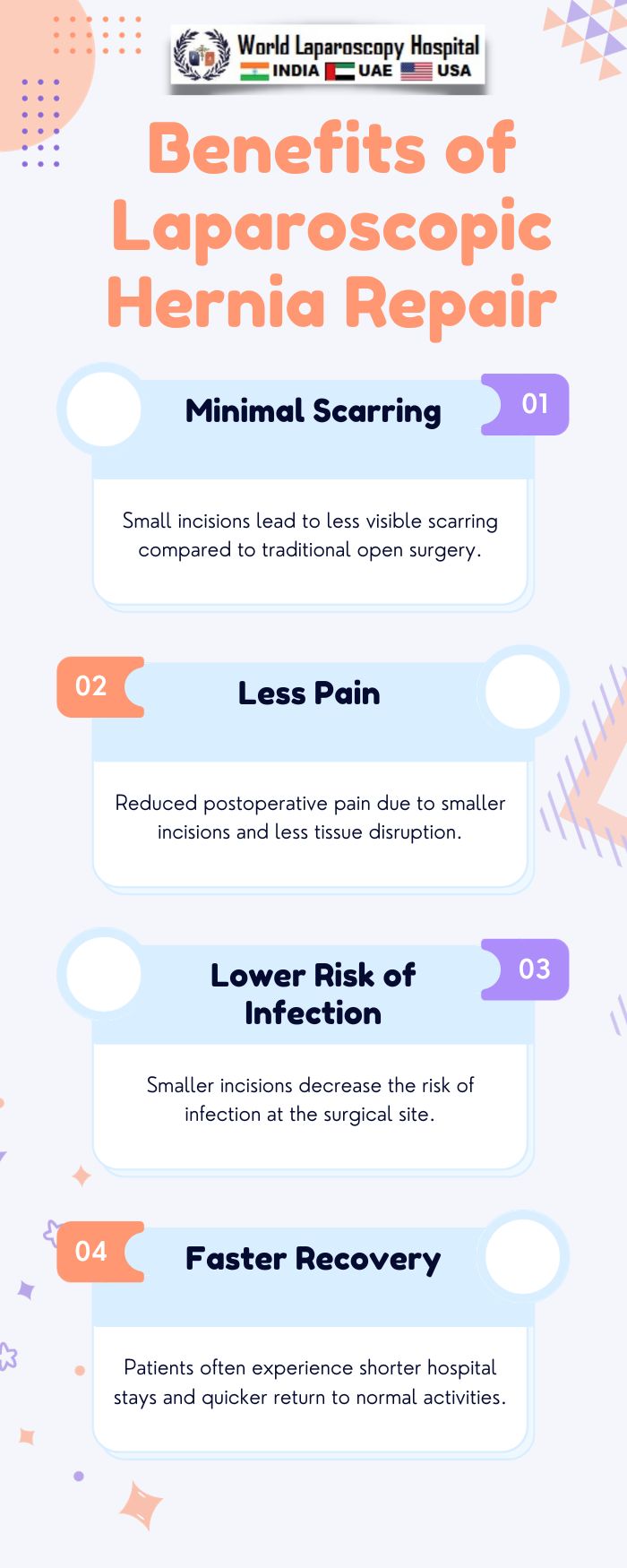Benefits of Laparoscopic Hernia Repair
Introduction
Hernias are a common medical condition that affects millions of people worldwide. They occur when an internal organ or tissue pushes through a weak spot in the muscle or connective tissue that surrounds it. While hernias can occur in various parts of the body, the most common types include inguinal hernias (in the groin area), umbilical hernias (around the navel), and ventral hernias (in the abdominal wall). Traditionally, hernias have been repaired through open surgery, but in recent years, laparoscopic hernia repair has gained popularity due to its numerous benefits. In this article, we will explore the advantages of laparoscopic hernia repair, shedding light on why it has become the preferred choice for both patients and surgeons.

Understanding Laparoscopic Hernia Repair
Laparoscopic hernia repair, also known as minimally invasive hernia surgery or laparoscopic hernioplasty, is a surgical technique that involves making several small incisions rather than a single large one. Through these small incisions, the surgeon inserts a thin tube with a camera (laparoscope) and specialized instruments. The camera provides a magnified view of the hernia and surrounding tissue on a monitor, allowing the surgeon to perform the repair with precision.
Benefits of Laparoscopic Hernia Repair
Smaller Incisions and Minimal ScarringOne of the most significant advantages of laparoscopic hernia repair is the use of smaller incisions. Traditional open hernia surgery requires a large incision, which can leave a noticeable scar. In contrast, laparoscopic surgery involves tiny incisions, typically less than an inch in length. These smaller incisions result in minimal scarring, which is cosmetically appealing to patients. The reduced scarring is particularly important for those with cosmetic concerns or for hernias in visible areas like the abdomen.
Faster RecoveryLaparoscopic hernia repair offers a faster recovery compared to open surgery. With smaller incisions and less tissue disruption, patients experience less postoperative pain and discomfort. This leads to shorter hospital stays and a quicker return to daily activities. Many patients can resume light activities within a few days and return to work sooner than with open surgery. The speedier recovery is a significant advantage, especially for individuals with busy lives and work commitments.
Reduced Risk of InfectionIn open hernia surgery, the large incision exposes the surgical site to a higher risk of infection. Laparoscopic hernia repair minimizes this risk because the small incisions are less likely to become contaminated. Surgeons also use specialized sterile techniques during the procedure to further reduce the risk of infection. Lower infection rates contribute to better overall patient outcomes.
Less Postoperative PainPostoperative pain is a common concern for patients undergoing any surgical procedure. Laparoscopic hernia repair typically results in less postoperative pain compared to open surgery. This is because the smaller incisions cause less trauma to the surrounding tissues. In addition, the laparoscopic approach allows for better visualization and precise placement of mesh, reducing the likelihood of nerve irritation, which can contribute to pain.
Lower Risk of Hernia RecurrenceThe use of mesh in laparoscopic hernia repair has been shown to reduce the risk of hernia recurrence significantly. The mesh is placed over the weakened area of the abdominal wall, providing additional support and preventing the hernia from returning. This reduced recurrence rate is a crucial benefit of laparoscopic hernia repair, as recurrence can be a significant concern for patients who undergo open surgery.
Improved Cosmetic OutcomesFor patients concerned about the cosmetic appearance of their surgical scars, laparoscopic hernia repair offers a clear advantage. The small incisions result in less noticeable scars, and they are often strategically placed in areas that are less visible, such as the lower abdomen or the groin. This can boost patients' confidence and satisfaction with the surgical outcome.
Enhanced Surgical PrecisionLaparoscopic hernia repair provides surgeons with a magnified, high-definition view of the hernia and surrounding tissue. This enhanced visualization allows for precise placement of the mesh and sutures, reducing the risk of complications. Surgeons can identify and address any additional hernias or issues that may be present, improving the overall success of the procedure.
Lower Risk of Seroma FormationSeroma is a potential complication of hernia surgery where a pocket of fluid collects at the surgical site. Laparoscopic hernia repair has been associated with a lower risk of seroma formation compared to open surgery. The minimally invasive approach minimizes tissue disruption, reducing the likelihood of fluid accumulation.
Minimal Blood LossLaparoscopic hernia repair typically results in minimal blood loss during the procedure. The use of smaller incisions and specialized instruments helps control bleeding effectively. This is especially beneficial for patients with underlying medical conditions that may affect clotting or those who are concerned about potential blood loss.
Customized ApproachLaparoscopic hernia repair allows for a customized approach to each patient's specific hernia. Surgeons can tailor the procedure to the size, location, and complexity of the hernia, ensuring that the repair is optimized for individual needs. This personalized approach contributes to better outcomes and patient satisfaction.
Conclusion
Laparoscopic hernia repair has revolutionized the treatment of hernias by offering numerous advantages over traditional open surgery. From smaller incisions and minimal scarring to faster recovery, reduced pain, and lower risk of complications, the benefits of this minimally invasive approach are clear. Patients who undergo laparoscopic hernia repair often experience improved cosmetic outcomes and a quicker return to their daily lives. As technology and surgical techniques continue to advance, laparoscopic hernia repair will likely remain the preferred choice for both patients and surgeons seeking the best possible outcomes for hernia repair surgery. If you or a loved one is considering hernia repair, discussing the option of laparoscopic surgery with a qualified surgeon is a prudent step toward a successful and minimally invasive recovery.
| Older Post | Home | Newer Post |

